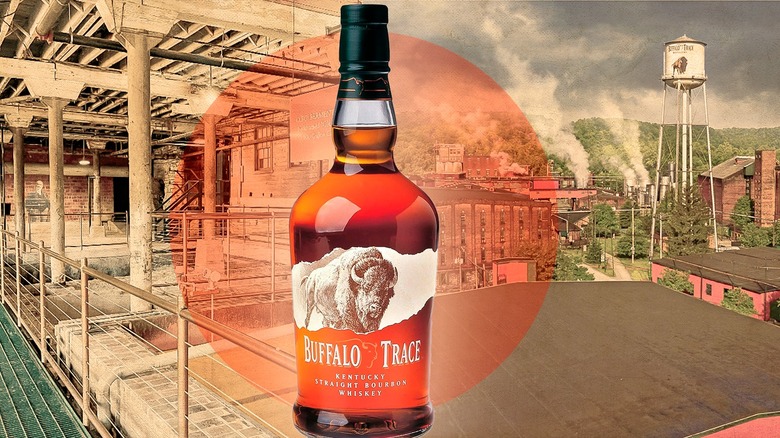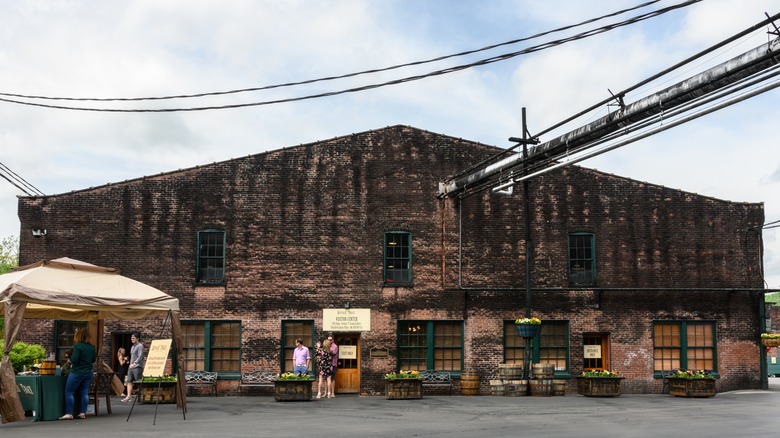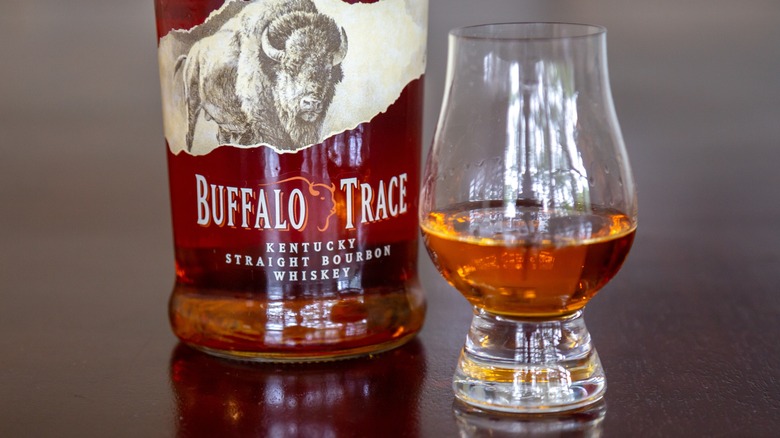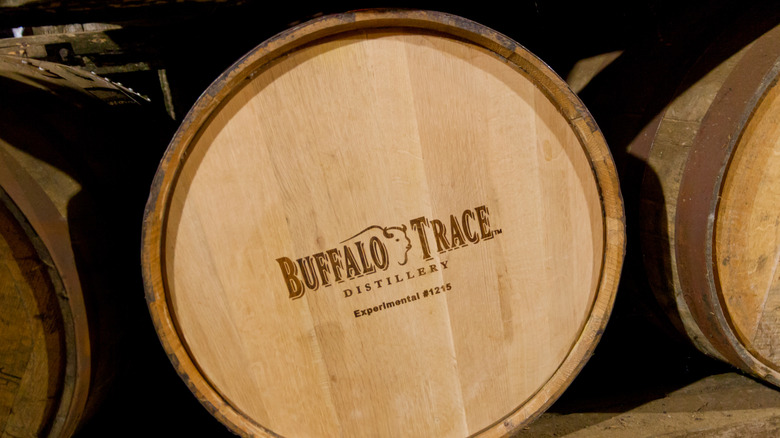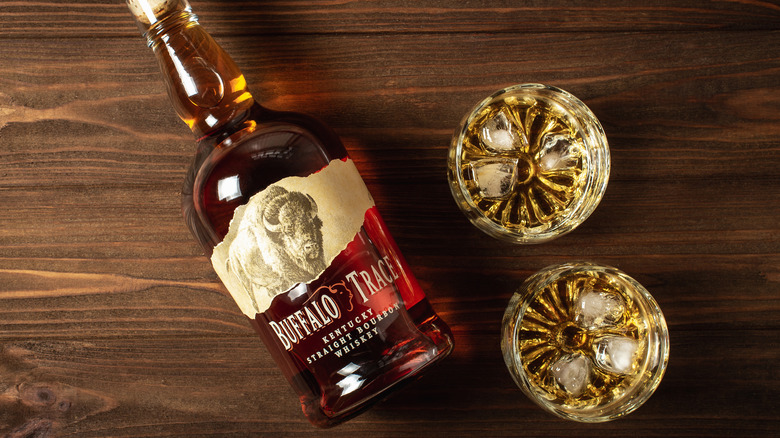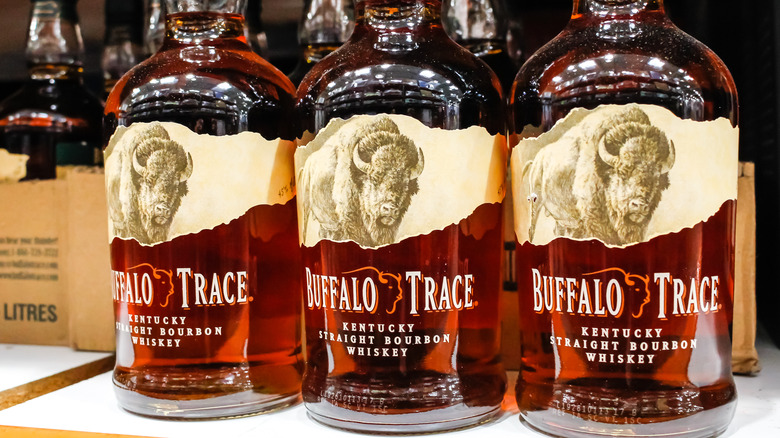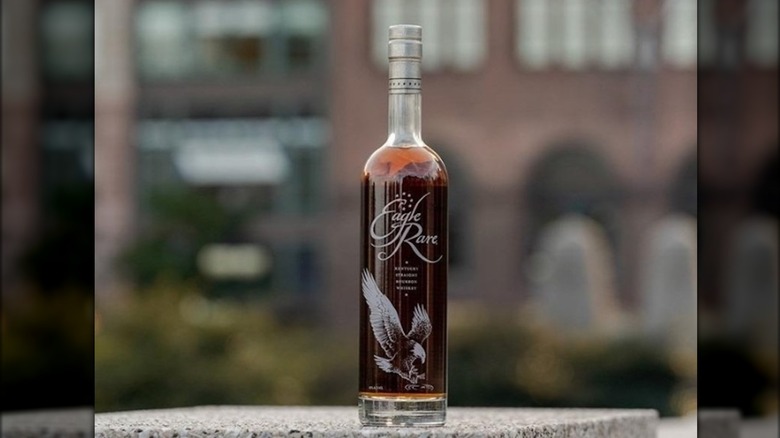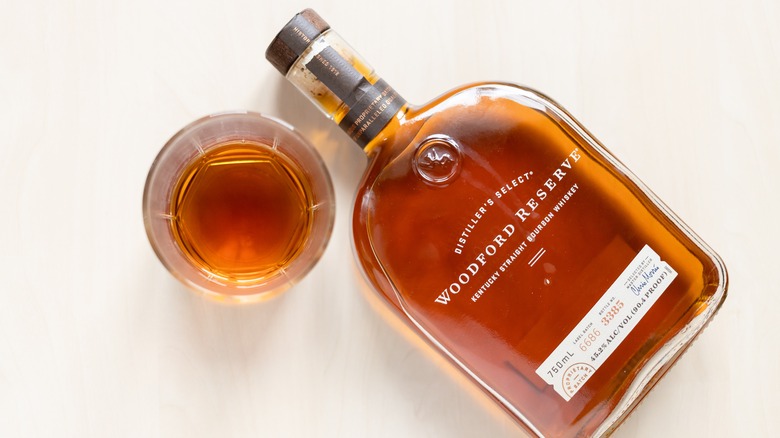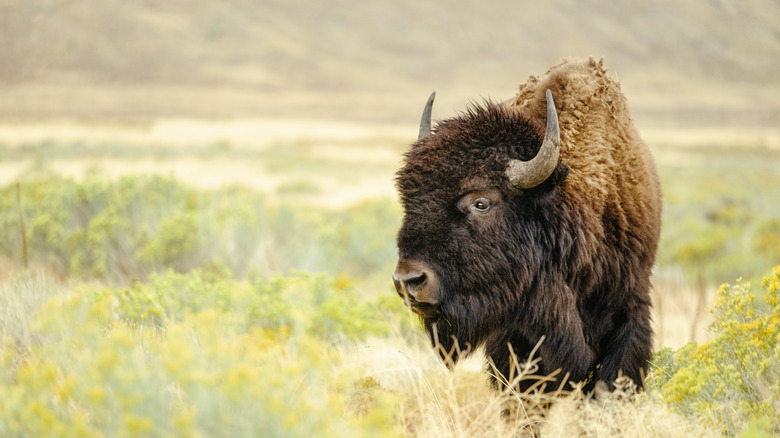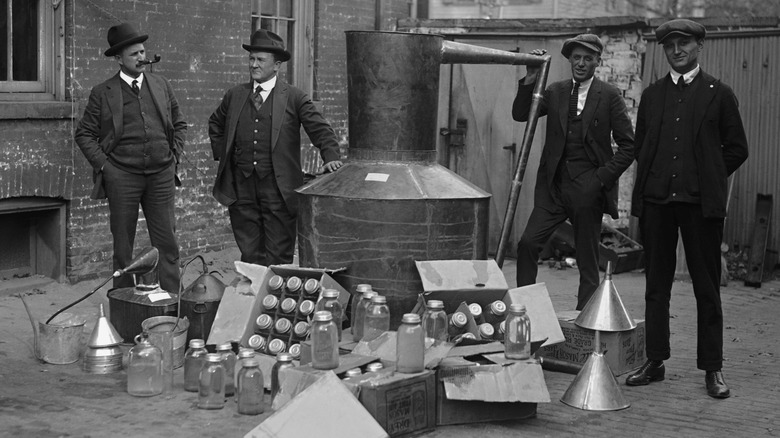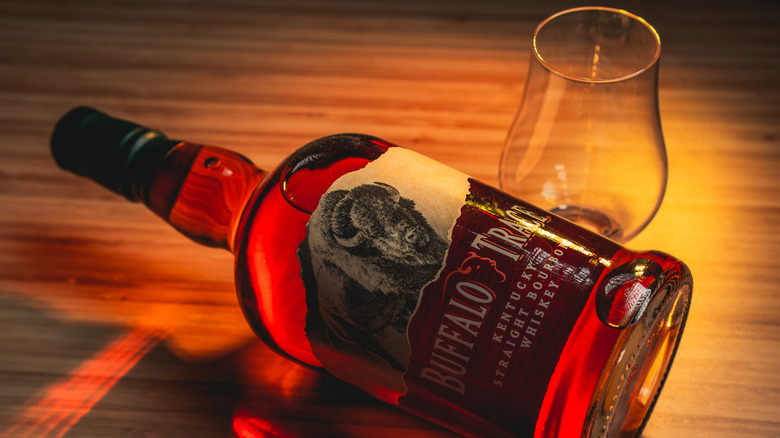Buffalo Trace Bourbon: The Ultimate Bottle Guide
There are few flavors as distinctly American as bourbon. Sipping on the amber-colored spirit conjures up images of Kentucky thoroughbreds grazing in bluegrass as storehouses lined with white oak barrels protecting the aging whiskey. As the world's bourbon capital, Kentucky produces 95% of the global supply. While there are nearly one hundred distilleries to sample around the state, Frankfort-based Buffalo Trace Distillery is one of the most beloved with over two centuries of history and more awards than any other distillery in the world in recent years. What has kept the oldest continuously operating distillery in America in business for so long? Buffalo Trace honors the traditions of its history, adheres to strict quality control in every step of the distilling process, and continues to seek innovation.
Many recognize the distillery's flagship brand, Buffalo Trace Bourbon, from its curved bottle featuring a sepia-toned buffalo staring back from the bar and liquor store shelves. This classic bourbon offering is both sweet and smooth. Bottled at 90 proof, Buffalo Trace Bourbon is an approachable favorite for both sipping and mixing. Industry experts have recognized the flagship bourbon with many awards since it launched in 1999, including taking gold in the 2020 American Whiskey Masters. To keep up with demand, Buffalo Trace Distillery embarked on an expansion that will increase its production by 50%. Fans will soon have more Buffalo Trace Bourbon to enjoy than ever. Before your next pour of Buffalo Trace Bourbon, learn what makes this whiskey so storied.
History of Buffalo Trace
Buffalo Trace Bourbon benefits from more than 200 years of distillery history. What began as the small Swigert Distillery in 1858 was purchased in 1870 and renamed O.F.C. for Old Fire Copper, referencing its wood-fired copper stills. In 1904, it was renamed the George T. Stagg Distillery after its former owner. After the Sazerac Company purchased the distillery in 1992, it spent seven years renovating the facilities. It rebranded to Buffalo Trace Distillery in 1999 and launched Buffalo Trace Bourbon that same year, advancing more than two centuries of bourbon heritage.
Its history is so distinguished that in 2013, the United States Department of the Interior designated Buffalo Trace as a National Historic Landmark. It joined the esteemed list of significant sites in American history and culture like Mount Vernon, Pearl, Harbor, and Martin Luther King's Birthplace. Buffalo Trace has the unique distinction of operating before, during, and after Prohibition. According to the landmark submission, this makes it an ideal location to study the history of the whiskey industry through its buildings and distillery resources. Today, visitors can admire pieces of Buffalo Trace's heritage including the one-story "Old Taylor House" built by Commodore Richard Taylor in 1792, Warehouses A and B which have been aging barrels since 1881, and "Bourbon Pompeii," home to the foundations of two previous distilleries and a fermenter dating to 1883 that's distilling whiskey again.
What does Buffalo Trace Bourbon taste like?
Part of Buffalo Trace Bourbon's broad appeal is its classic bourbon expression. Tasting whiskey starts through the nose, and Buffalo Trace Bourbon first offers sweet notes of vanilla and caramel. The aroma of spices cuts through the butterscotch sweetness, followed by oak and fruit. Notes of apple and honey along with the spice bring apple pie to mind.
While the nose is as sweet as honey, Buffalo Trace's taste packs a spicy punch. The first flavors of cinnamon, black pepper, and anise eventually give way to caramel and brown sugar. Next, the complex flavor profile delivers oak and toffee for an earthy finish. Adding a drop of water reduces the bite of the spice and opens up the caramel and fruit notes for a sweeter, rounder palate.
Buffalo Trace finishes long, with a satisfying, lingering heat. The spicier rye notes give way to oak and vanilla for a flavorful, woodsy finish. Buffalo Trace's smooth yet robust taste stays with you. With a quintessential bourbon profile, Buffalo Trace Bourbon is approachable yet provides ever-evolving flavors that keep bourbon fans coming back for more.
How is Buffalo Trace Bourbon made?
All bourbon contains at least 51% corn, and Buffalo Trace uses a lot of corn. While its mash bill, or recipe, is a secret, Buffalo Trace subjects every kernel to intense scrutiny on its journey from the field to the mash. It only uses corn that's hand-picked locally on farms in Kentucky and Indiana. Once the grains arrive at the distillery laboratory, technicians evaluate their quality, moisture, and composition to ensure they meet the Buffalo Trace standards. Next, the grains are milled to 10/64 of an inch in diameter. These exact specifications allow the kernels to cook properly and not become too thick during the cooking process.
Even Buffalo Trace's barrels are subject to high standards. They're made using center-cut wood with nine growth rings per inch from white oak trees that are naturally aged at about 70 to 80 years. After air drying for six months, each barrel receives a number four char from an open flame lasting for 55 seconds. While bourbon lovers patiently wait, the whiskey matures in the barrels for six to eight years.
Buffalo Trace has several aging warehouses dating back to 1881. The age, materials, size, and design of each warehouse as well as the placement of barrels within the warehouse all affect the bourbon's aging process. In 1886, Buffalo Trace was the first distillery to use steam heat to control the warehouse climate during the cold months and keep whiskey mellowing, and it continues this method today.
How to drink Buffalo Trace Bourbon
There are probably as many ways to drink whiskey as there are kinds of whiskey, yet there's no one "right" approach. Buffalo Trace does encourage comparing the neat pour to a pour with a bit of water added to your bourbon to soften the alcohol and open up more flavors. Freddie Johnson, Buffalo Trace's VIP Visitor Lead, recommends adding a few drops of spring water. "Get acclimated by starting with a sip of water in your mouth then take a sip of bourbon," he told ShortList.
Yet Buffalo Trace Bourbon isn't just for bourbon purists. Its sweet and spicy profile makes it a favorite to mix in cocktails from mules to Old Fashioneds. From enjoying a classic whiskey sour to adding a punch to a root beer float or frozen Coke, there are countless ways to get creative with this versatile spirit. But we certainly wouldn't begrudge you for drinking it neat, either.
Is Buffalo Trace Bourbon expensive?
Fortunately for bourbon fans, Buffalo Trace Bourbon is accessible in both palate and price tag. Averaging around $38 per bottle, Buffalo Trace Bourbon appeals equally to the curious seeking an approachable entryway to bourbon, those looking for a flavorful base for their cocktails, and anyone seeking a quintessential, drinkable bourbon.
While Buffalo Trace's roster includes pricier brands like W.L. Weller, Colonel E.H. Taylor, and even the iconic Pappy Van Winkle, Buffalo Trace Bourbon offers whiskey fans a more affordable alternative to those acclaimed labels and top-shelf price tags. Yet the renowned Buffalo Trace name and cost-effective price point have made Buffalo Trace Bourbon difficult to find in some markets.
Buffalo Trace Bourbon offers a good value for money if you can find it in your market. Flagship brands are known for balance and consistency, so Buffalo Trace Bourbon doesn't have too many surprises up its sleeve. Yet this makes it a reliable mid-tier bourbon choice that works well in a variety of applications. You know what you're going to get from Buffalo Trace Bourbon, and what you're going to get is good.
Buffalo Trace Bourbon vs. Eagle Rare Bourbon
So how does the flagship Buffalo Trace Bourbon compare to other Buffalo Trace brands? Both Buffalo Trace Bourbon and Eagle Rare Bourbon are produced by Buffalo Trace Distillery, so they're subject to the same exciting quality standards. Both bourbons are similar in alcohol content, bottled at 90 proof.
Where these two popular labels differ is in aging, with Buffalo Trace Bourbon aging for six to eight years and Eagle Rare aging for at least 10 years. This extra time in the barrel gives Eagle Rare a bolder, more complex flavor while Buffalo Trace Bourbon is sweeter and smoother. Eagle Rare's more mature profile comes through with darker fruit and wood notes in both nose and flavor. Where Buffalo Trace Bourbon offers flavors of vanilla and honey, Eagle Rare's palate delivers oak and leather.
With longer aging and a more limited supply, Eagle Rare is currently about double the cost of Buffalo Trace Bourbon. If you're looking for a balanced bourbon that's consistent from mixing to sipping, stick with Buffalo Trace Bourbon. On the other hand, reach for Eagle Rare if you're interested in exploring richer flavors and enjoying bourbon neat or on the rocks.
Buffalo Trace Bourbon vs. Woodford Reserve Bourbon
Buffalo Trace Bourbon and Woodford Reserve Distiller's Select Bourbon come from two lauded bourbon distilleries with long histories and beloved followings. While Woodford Reserve may have traditionally had a slightly higher price point, it currently goes for about the same price as Buffalo Trace Bourbon. Similar to Buffalo Trace Distillery, the Woodford Reserve Distillery dates back to 1812 and went by a few different names before being renamed in the 1990s. Both of these bourbons are Kentucky straight bourbon whiskey and they have similar alcohol content with Woodford Reserve slightly higher at 90.4 proof to Buffalo Trace Bourbon's 90 proof.
After fermenting, Buffalo Trace Bourbon is twice distilled using modern column stills. Woodford Reserve, meanwhile, is distilled using traditional copper pot stills, requiring triple distillation, combined in a batching process with spirit from a column still.
We can't compare mash bills between the bourbons because Buffalo Trace keeps its proportions a secret, but Woodford Reserve Bourbon uses 72% corn, 18% rye, and 10% malted barley. While they both offer smooth, approachable bourbons, the Buffalo Trace Bourbon delivers more spice and oak flavors while Woodford Reserve Bourbon is creamier and nuttier. Woodford Reserve Bourbon is more golden in color than Buffalo Trace Bourbon. It has a softer nose with notes of caramel, vanilla, and dried fruit. Woodford Reserve Bourbon is more mellow than Buffalo Trace Bourbon with flavors of vanilla, almond, and spicy cinnamon heat. The spice lingers on the finish with more vanilla and tobacco notes.
The name comes from buffalo migration patterns
If you've ever wondered about the distillery's namesake buffalo, you aren't alone. There's a historic reason behind Buffalo Trace's name. While we tend to associate buffalo with the American West and not Kentucky, buffalo roamed the region long ago and even helped shape it. As American bison migrated west to the Great Plains, thousands of these giant animals carved a 12 to 20-foot-wide route through the wild landscape.
This "Great Buffalo Trace" was a convenient route for early pioneers and explorers including Daniel Boone and George Rogers Clark. In the 1770s, early settlers followed the Great Buffalo Trace to the Kentucky River and established Leestown on the land now home to Buffalo Trace Distillery. Both the distillery and its flagship bourbon are named for the animals that shaped local history, enabling early Americans to settle what would become Kentucky.
"The buffalo is a strong, massive animal. It is not going to be pushed around," Buffalo Trace Distillery brand manager Kris Comstock told The Spirits Business. "The buffalo on the label represents the independence and spirit of those early Americans who wanted to find a new life for themselves, and who weren't afraid to explore unchartered territory."
Buffalo Trace was prescribed by doctors
For whiskey lovers, Prohibition was a dark time in United States history. The Eighteenth Amendment prevented the legal manufacture, sale, and transportation of alcoholic beverages in America from 1920 to 1933. However, Buffalo Trace stayed in operation thanks to doctor's orders. Alcohol was available for purchase to combat influenza and other illnesses if you had a medical prescription. The Liquor Concentration Act of 1922 allowed the United States government to manage the legal stock of whiskey available for medicinal purposes by concentrating that supply in sanctioned warehouses. Known at the time as the George T. Stagg Distillery, Buffalo Trace was granted a license to bottle whiskey from other distilleries for medicinal use.
As the country's medicinal whiskey stock gradually depleted, the government allowed a few distilleries to produce new whiskey. From 1930 to 1933, it was one of only six distilleries granted a license from the government to produce alcohol during Prohibition. Why was Buffalo Trace selected to be one of these esteemed producers? It may have come down to connections. E.H. Taylor, who purchased Buffalo Trace in 1869, was a nephew of President Zachary Taylor and a distant relative of President James Madison, according to The Tennesseean. Today, you can toast to the end of Prohibition with Buffalo Trace's Prohibition Collection.
Buffalo Trace is becoming harder to find
The demand for whiskey in the United States is greater than ever. The Distilled Spirits Council of the United States reported that in 2022, spirits supplier revenues surpassed beer for the first time and American whiskey sales grew by 10.5% to $5.1 billion. "About five years ago, the popularity of Buffalo Trace began to spike in the U.S. and we still don't have enough Bourbon to supply the demand," Buffalo Trace Distillery brand manager Kris Comstock told The Spirits Business.
The distillery is betting big on the future of bourbon with a $1.2 billion expansion. It increased production by 50% in the first stages of the expansion. Since starting the project in 2016, the distillery has added a new hammer mill, distribution center, bottling operation, cooling system, 14 barrel warehouses, 12 fermenters, and cookers, and expanded its visitor center. Its wastewater treatment plant will process 1.2 million gallons of water per day.
In 2023, Buffalo Trace opened a new dry house and still house that will double Buffalo Trace's production to 60,000 gallons a day. Creating bourbon as beloved as Buffalo Trace takes years from field to glass, so while the newly produced spirits won't hit the shelves for a while there's no doubt that a thirsty bourbon fanbase will be waiting.
